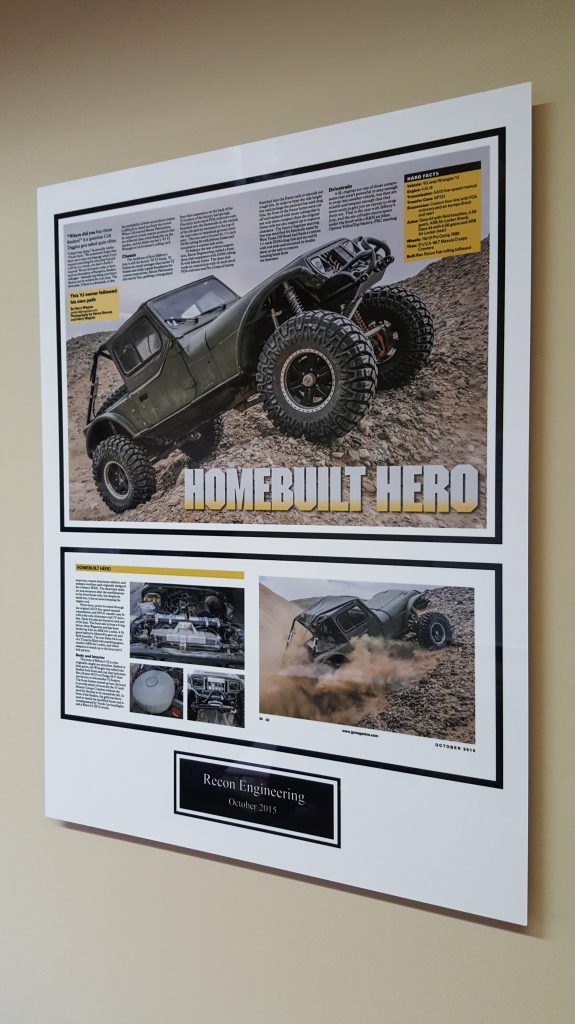Framing anything is a tough call at the best of times. What kind of frame should you use? How can you use the frame to keep it preserved? Is it even a good idea to frame the article or should you store it in some form of safe storage for paper? Well, we’re here to provide a few answers for you and hopefully sort out some of the major questions about framing magazine articles and teach you the basics of how to preserve and frame articles written on magazine stock.
Keep The Paper Out Of Sunlight
First and foremost: sunlight and major sources of ultraviolet light is heavily detrimental to most printed materials. While magazines are a little less susceptible to this effect, you should still be watching your environment to see if the article will be exposed to sunlight. If it is, you’ll need to take very specific actions to prevent damage to your preserved magazine article.
First thing you need to know is that the best way to prevent sunlight damage is to keep the framed article out of the sunlight at all. While indoor lights can do the same thing to the paper, the effects are less substantial than sunlight is and it can help keep the paper from yellowing or decomposing.
If you have to keep the article in the sunlight or in heavy lighting situations, you may consider making a copy of the article onto plastic or some other material that’s not heavily affected by the sun before framing it and keeping the original article in storage to prevent damage. That way, you can keep the original publication untouched while also showing the article off to your employees, clients, friends, and family. It’s the best of both worlds!

Acid-Free Environments Are The Place To Be
Another thing you should know is that if you’re framing using any materials that have acids in them or leak acids, you could be damaging the article. Worse, paper products have acids in them depending on what kind of magazine you’ve been featured in, so even if you’ve ensured that you’re using all acid-free materials, you might still get some paper degradation from the acids that are in the paper itself. This is why preserving articles is tricky: even the material the article’s printed on is working against you.
This is why making sure that the environment that the article is in has no acids is an important thing. If you don’t, it’ll degrade quickly. Luckily, framing the article takes care of most of the environmental issues, but you want to make sure that any articles you do frame are placed in acid free frames using acid free materials. Otherwise, there’s a great chance that you’ll have acid damage on your article with little way to repair the article—meaning that you’ll end up with nothing to show but yellowed, brittle paper and a display that doesn’t quite look like it’s supposed to.
Deacidification
Deacidification sounds complex, but in fact it’s a fairly simple thing these days—if you can purchase the materials needed to do what needs done. Remember earlier when we mentioned that the paper itself might have acids in it? Well, librarians and archivists have long known about this problem and there are companies that make products that neutralize the acids commonly found in papers to aid in preservation and protection of documents. That means that you can easily create a neutral environment for the paper.
Most of the products are available as sprays, so you’ll just need to treat the paper according to the directions on those products. Home remedies are not recommended as they’re not controlled for proper pH balance and can turn your paper basic/alkaline (which is just as bad). Most of these sprays are simple to use and can aid in the protection of your article for a long time. Combine that with the framing tricks that we told you about earlier and you’ve got a solution for a long-lasting magazine article framing.
Placement Tips and Tricks
There are very few frames that are truly air-tight, meaning that no matter how much work you put into your preservation and framing, there will still be environmental concerns to deal with. However, there are some tips and tricks that you can do to help ensure that your framing stays safe and beautiful for display:
- Keep the display out of strong lights Sunlight’s been mentioned before, but if you’re in an office that uses a lot of bright lights (especially ones that emit any form of ultraviolet rays), the paper can degrade in the display. Be sure to keep the article somewhere it can be seen and appreciated, but not necessarily exposed to spotlights or tons of fluorescent lights.
- Keep the display away from open air Environmental concerns exist even if the display is “sealed.” Air and moisture can leak into the frame, which can aid in the decomposition of the paper. And, if you’re in an urban environment, smog and other pollutants can discolor the paper or raise the acidity, aiding in the destruction of your article. Don’t let exterior pollutants destroy your work.
- Keep the display away from accident-prone areas If you’re placing your work somewhere where people can touch or manipulate it, you’re exposing it to accidents and human error. This might be as simple as a broken plaque, but if someone were to spill coffee, tea, or a soft drink on the framed article, you might end up with a stained, ruined article—which is the opposite of what you’d want! Keep the article up high, away from people and accidents.
- Keep the display away from fire hazards While a good frame is made from fireproof materials, that doesn’t make the frame any less susceptible to fire. Paper combusts at 451 degrees regardless of its exposure to open flame. If it’s in the frame, it’ll burn just as though it weren’t if it hits that temperature. Keep the display away from lighters, electrical cords, kitchens, or other possible fire hazards to maintain the beauty and safety of your framed magazine article.
Professional Framing
If, after reading all of these tips, you decide that it might not be a great idea, it still is—you just may need some professional help. Regardless of how easy it seems, a good framing takes a lot of work and effort to succeed at. Deacidification, proper placement, and proper mounting are essential to preserving your frame. If you decide to do it yourself, be sure to follow all of the tips above as well as speaking to a framer to find out conditions that might be specific to your location.
However, if you want to have the framing done all at once, you might consider us here at That’s Great News. We’ve gotten the process down to a science and we can do all the things necessary to ensure that you have a proper framing done and a display that’ll last as long as your business does (at least). Don’t be discouraged—you’ll be incredibly pleased with the work after it’s all done. Call us today if you’re interested in having us frame your article or even just consulting. We’re here to assist!







